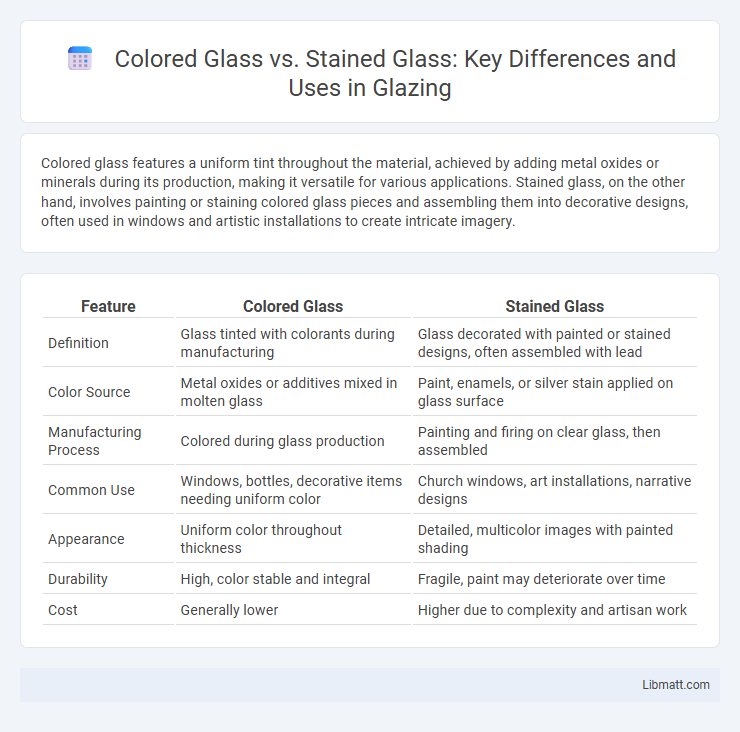Colored glass features a uniform tint throughout the material, achieved by adding metal oxides or minerals during its production, making it versatile for various applications. Stained glass, on the other hand, involves painting or staining colored glass pieces and assembling them into decorative designs, often used in windows and artistic installations to create intricate imagery.
Table of Comparison
| Feature | Colored Glass | Stained Glass |
|---|---|---|
| Definition | Glass tinted with colorants during manufacturing | Glass decorated with painted or stained designs, often assembled with lead |
| Color Source | Metal oxides or additives mixed in molten glass | Paint, enamels, or silver stain applied on glass surface |
| Manufacturing Process | Colored during glass production | Painting and firing on clear glass, then assembled |
| Common Use | Windows, bottles, decorative items needing uniform color | Church windows, art installations, narrative designs |
| Appearance | Uniform color throughout thickness | Detailed, multicolor images with painted shading |
| Durability | High, color stable and integral | Fragile, paint may deteriorate over time |
| Cost | Generally lower | Higher due to complexity and artisan work |
Understanding Colored Glass: Definition and Types
Colored glass refers to glass that has been infused with various metal oxides or chemicals during its molten state to produce a uniform hue throughout the material. Types of colored glass include transparent colored glass, which maintains clarity while adding tint, and opalescent glass, characterized by its milky, iridescent appearance achieved through mixing opaque materials. Unlike stained glass, which is typically clear glass painted or stained on the surface with colored pigments and then fired, colored glass's coloration is intrinsic, offering consistent color saturation and durability.
What is Stained Glass? Key Characteristics
Stained glass is a type of colored glass that is crafted by adding metallic salts during its manufacture to produce various hues, often assembled into intricate designs using lead cames. Key characteristics include its translucency, vibrant colors, and the ability to form detailed pictorial or geometric patterns typically seen in windows of churches and historic buildings. Unlike painted or plain colored glass, stained glass integrates color directly into the glass itself, resulting in durability and brilliance when illuminated by natural light.
Historical Origins: Colored Glass vs Stained Glass
Colored glass originated in ancient Egypt and Mesopotamia, where natural minerals were added to molten glass to create vibrant hues used in beads and vessels. Stained glass, emerging in medieval Europe around the 12th century, involves painting and firing glass pieces, often depicting religious scenes in cathedrals. Understanding these distinct historical origins enhances your appreciation of the intricate craftsmanship and cultural significance behind each art form.
Differences in Manufacturing Processes
Colored glass is produced by adding metal oxides or other coloring agents to molten glass, resulting in uniform coloration throughout the material. Stained glass involves applying pigments, paints, or enamel to the surface of clear or colored glass, followed by firing to fuse the design, allowing for detailed images and patterns. Your choice depends on whether you prefer consistent color or intricate artistic designs created by distinct manufacturing techniques.
Aesthetic Appeal: Color, Texture, and Visual Impact
Colored glass features uniform hues and smooth textures that create vibrant, consistent light effects, while stained glass combines multiple colors and textures through painted or leaded pieces to produce intricate, detailed imagery with dynamic visual depth. The interplay of light in stained glass enhances architectural spaces with storytelling elements and varied translucency, providing a richer, more complex aesthetic appeal than solid colored glass. Your choice will impact the ambiance and artistic expression, balancing simplicity with ornate design depending on the desired visual impact.
Common Uses in Architecture and Art
Colored glass is frequently used in modern architectural applications for windows, facades, and decorative panels, offering uniform hues that enhance natural light and create ambient environments. Stained glass, with its intricate designs and vivid color variations, is predominantly found in historic churches, cathedrals, and traditional art installations, serving both aesthetic and storytelling purposes. Both types contribute to visual interest and light manipulation but differ in complexity and cultural significance within architectural and artistic contexts.
Durability and Maintenance Considerations
Colored glass offers greater durability and requires minimal maintenance as it is uniformly tinted throughout the material, resisting fading and chipping over time. Stained glass, featuring surface-applied pigments and lead came, is more vulnerable to environmental damage and demands regular cleaning and careful restoration to preserve its intricate designs. Proper sealing and protective glazing are essential for stained glass to prevent moisture infiltration and corrosion.
Cost Comparison: Colored Glass vs Stained Glass
Colored glass typically costs less than stained glass due to simpler manufacturing processes and fewer materials involved. Stained glass requires intricate hand-painting, leading to higher labor costs and increased overall price. Budget considerations often favor colored glass for large-scale projects, while stained glass is preferred for detailed, artistic installations despite its premium cost.
Environmental Impact and Sustainability
Colored glass is typically produced by adding metal oxides during the molten stage, resulting in vibrant hues without additional processing, which can lower energy consumption compared to stained glass production. Stained glass involves multiple steps such as cutting, painting, and firing, increasing energy use and generating more waste, thus having a higher environmental footprint. Choosing colored glass supports sustainability through simpler manufacturing and better recyclability, reducing overall carbon emissions in the glass industry.
Choosing the Right Glass for Your Project
Colored glass offers uniform tinting and is ideal for modern designs needing consistent color and light transmission, while stained glass features painted details and leaded seams perfect for intricate, artistic windows. Your choice depends on the desired aesthetic, budget, and durability requirements, as colored glass tends to be more affordable and low-maintenance compared to the handcrafted complexity of stained glass. Understanding these differences ensures your project achieves the intended visual impact and longevity.
colored glass vs stained glass Infographic

 libmatt.com
libmatt.com